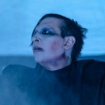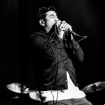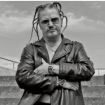On July 19th, 1994, Marilyn Manson's debut album Portrait of an American Family was unleashed upon an unsuspecting public. Little known outside of their South Florida stomping grounds, where their outrageously theatrical live performances had earned them a sizeable cult following, the band originally known as Marilyn Manson & the Spooky Kids were ready to take the world by storm with their button-pushing brand of industrial metal.
Unfortunately, their first full-length assault on society had a difficult birth. Signed to Trent Reznor's Nothing label, the band first tracked the record — provisionally titled The Manson Family Album — in Florida in the summer and fall of 1993 with producer Roli Mosimann, but were bitterly disappointed with the results. "When we were finally finished, Roli had done the opposite of what I'd expected," recalled frontman and band leader Marilyn Manson (birth name Brian Warner) in his 1998 book with Neil Strauss, The Long Hard Road Out of Hell. "I thought he was going to bring out some sort of dark element. But he was trying to polish all the rough edges and make us more of a rock band, a pop band, which at the time I wasn't interested in at all. I thought the record we did with him came out bland and lifeless. Trent thought the same thing so he volunteered to help us repair what had been damaged."
With Reznor at the helm, assisted by Sean Beavan and Alan Moulder, songs like "Cake and Sodomy," "Lunch Box" and "Wrapped in Plastic" finally lurched to throbbing life, reeking of carnival sideshow sleaziness and pulsating with irreverent humor (telegraphed in part by dialogue samples from John Waters' trash classic Desperate Living and the 1970s kids TV show Lidsville) — though the latter element went largely unnoticed by critics of the time, most of whom focused instead on the record's shocking lyrical and visual imagery.
With Interscope — Nothing's parent company — queasy about promoting the now-renamed Portrait of an American Family, the band largely had to spread the word through their live shows; the album wouldn't even make the Billboard Heatseakers chart until the following year, and it wouldn't surpass the "gold" mark of 500,000 copies sold in the U.S. until 2003. The band would have to wait until 1996 to really make their mark on the mainstream, thanks to the one-two punch of their cover of Eurythmics' "Sweet Dreams (Are Made of This)" (from their 1995 EP Smells Like Children) and "The Beautiful People," the lead single from 1996's Antichrist Superstar.
Though Manson has often referred to the latter album as the record where all of his band's musical, lyrical and conceptual elements really fell into place, he still holds some fondness for Portrait of an American Family. "This is where it all began," he told Kerrang! earlier this year. "For the longest time I didn't think this album was as good as it could have been, but now when I listen to it, it sounds way better than I remember."
While Manson and his cohorts would sink to greater depths of decadence in the coming years, there was still no shortage of insanity on tap during the making of Portrait of an American Family. Here are eight of the strangest stories from the sessions.
1. Original producer Roli Mosimann kept losing his teeth
Despite his impressive track record with such darkly brutal bands as Swans, Young Gods and Celtic Frost, Roli Mosimann turned out to be a terrible fit for Marilyn Manson. Not only did he try to make the band's music more pop-sounding, but Manson himself was appalled by both the producer's chain-smoking and apparent lack of dental hygiene. "[Mosimann] was a weird character," Manson would later recall in The Long Hard Road Out of Hell. "He had about six — maybe eight — teeth in his head. And while we were in the studio recording he lost two of them. And they were just falling out of his head, rotten, and he smoked all the time."
2. Daisy Berkowitz got "a bubble in his brain" from an alcohol-induced accident
Once Trent Reznor agreed to take over the project, the album sessions shifted to Los Angeles.
"I went out there by myself at first to try and remix the tracks I thought were still salvageable," Manson recalled in The Long Hard Road Out of Hell. But once he was ready for the rest of the band to join him and begin re-recording the remainder of the album, he discovered that guitarist Daisy Berkowitz (born Scott Putesky) wasn't ready to participate, thanks to injuries sustained during an alcohol-induced blackout.
"I called home to Florida to talk to Daisy and ended up talking to Pogo [the band's keyboardist at the time, Madonna Wayne Gacy, a.k.a. Stephen Bier]. He told me they were at [local club] Squeeze and they got really fucked up. Daisy couldn't handle his alcohol, and all of a sudden passed out while he was walking and fell right on his face. He split his chin open and lost his memory. He didn't know who he was when he woke up, and kept saying, 'Where's my car? Where's my car?' He thought he had been in a car accident I called him, and he sounded like another person. I couldn't communicate with him ... the doctors told him he had a bubble in his brain."
Berkowitz, who passed away in 2017 from colon cancer, eventually recovered in time to contribute to the album. He would leave the band for good during the sessions for Antichrist Superstar.
3. Gidget Gein OD'd on heroin on Christmas Eve, leading to his firing from the band
Berkowitz wasn't the only Manson member to overindulge during the making of Portrait of an American Family — according to Manson, bass player Gidget Gein (a.k.a. Brad Stewart), was often "passed out on heroin" at the recording sessions. When Gein overdosed on heroin on Christmas Eve 1993, it was the final straw; he was fired by the band's lawyer (allegedly via FedEx), and replaced by Twiggy Ramirez (a.k.a. Jeordie White), formerly of Florida band Amboog-a-Lard.
"We fired our other bass player ... not for being a heroin addict, but for letting heroin use rule his life," Manson told Seconds magazine in 1994. "We're very much into being strong and having control over our lives because we want to do something, however idealistic that may sound. We don't have time to babysit weak people. I tend not to advocate drugs to anybody. Use them how you want. It's your own discretion. We all use drugs in our own ways ... I thoroughly advocate the use of drugs. I completely hate the abuse of drugs." Gein would continue to struggle with heroin addiction for the rest of his life, finally dying from another overdose in 2008.
4. Manson invited Anton LaVey to play theremin on the album
A longtime admirer of Anton LaVey, Manson quite rightly surmised that it would be a significant coup to have the founder and high priest of the Church of Satan appear on his debut album. But rather than have LaVey utter some ominous incantations, Manson actually invited him to play the theremin, an eerie-sounding electronic instrument that is controlled by manually interacting with two radio frequency oscillators.
"I had originally written LaVey not to talk about human nature," he wrote in The Long Hard Road Out of Hell, "but to ask if he'd play theremin on Portrait of an American Family because I had heard he was the only registered union theremin musician in America." Though LaVey never acknowledged Manson's invitation, the two men did meet in late 1994 while Manson was on tour with Nine Inch Nails, and forged a friendship that would last until LaVey's death in 1997.
5. Charles Manson made an apparently supernatural appearance in the studio
As soon as Manson learned that Reznor had set up a studio in the same home on Cielo Drive in Beverly Hills where Sharon Tate, her unborn child, and four other people had been murdered in 1969 by followers of Charles Manson, he couldn't believe his luck. "The very first thing we said when we started the band was it'd be really interesting to find out who lives in the Sharon Tate house now and see if we could record there," he told Industrial Nation in 1994. "This was before Trent moved in and I thought it would be fitting to express all the anger and the fear we're trying to show everyone right in the place where all of those emotions actually manifested themselves."
But even Manson had to admit that he got a little spooked by something that happened at Reznor's studio while making Portrait of an American Family. One night, while mixing the song "Wrapped in Plastic," Manson and assistant producer Sean Beavan were surprised to hear samples taken from a vintage Charles Manson interview — which had been earmarked for use on an entirely different track — suddenly popping up on the track they were working on.
"We were using a computer because we had a lot of samples and sequencing. While we were working on that song the Charles Manson samples from 'My Monkey' started appearing in the mix," he recalled in The Long Hard Road Out of Hell. "All of a sudden we'd hear, 'Why are the children doing what they're doing? Why does a child reach up and kill his mom and dad and murder his two little sisters and then cut his throat?' And we couldn't figure what was going on. The chorus of 'Wrapped in Plastic' is, 'Come into our home/Won't you stay?' And we're in the Sharon Tate house, just me and Sean Beavan. We got scared and were like, 'We are done for the night.' We came back the next day and it was fine. The Charles Manson samples weren't even on the tape anymore. There's no real logical or technological explanation for why they appeared. It was a truly supernatural moment that freaked me out."
6. Pogo took up Manson on a certain prostitute challenge during the sessions
While re-recording the album's tracks at the Record Plant in Los Angeles, Reznor and Manson offered up a $150 bounty to the first person in the band to pick up one of the trans prostitutes who populated a nearby stretch of Santa Monica Boulevard, and have sex with them in the studio's live room while everyone watched. After Reznor, Manson and the rest of the band made an unsuccessful group foray into the area ("The prostitutes were clearly afraid of us," Manson recalled in The Long Hard Road Out of Hell), keyboardist Pogo painted his face in KISS-style makeup, and headed out on a solo mission.
He returned a while later with "Marie," who Manson described as "not that unattractive, at least for a prostitute ... but upon closer inspection we could see that underneath her fishnets there were some open sores on her legs that looked like they came either from being burned with giant cigars or the first stages of something that we didn't want to know about. What ended up happening was that she was smarter than we thought. She knew we were watching and wanted to charge extra." When Manson and his colleagues decided they didn't want to pony up additional cash for the privilege of watching them in action, Pogo and Marie repaired to a side room to finish up.
7. Manson freaked out the record company with a nude pic from his childhood
When the band presented their (re-)finished album to Interscope in January 1994, the label initially wanted them to scrub all references to Charles Manson from the record, and drop "My Monkey" — which featured a six-year-old boy singing lyrics written by Charles Manson — from the track listing. Meanwhile, folks at Time Warner, the label's parent company, refused to go along with the band's plan to put a naked photo of another six-year-old boy on the sleeve, even though that boy in question was actually a young Brian Warner.
As Manson told the Miami New-Times in 1994, the photo in question had been taken by his mother. "That was when Burt Reynolds had posed for Playgirl," he explained. "My mom thought it'd be funny to have me do that pose, lying on a couch. It's only sick if you have a sick mind. It was innocent. But they told me it would qualify as child pornography in 20 states."
While "My Monkey" and the Charles Manson references ultimately remained in place on the album, Manson had to back down on the inclusion of his nude photo. "I was a little pissed off," he explained, "But you also have to work within the limitations of the law ... There're 20 states that wouldn't carry it. What's the point in having something cool if no one can buy it?"
8. Madonna's manager mandated that Manson's tattoos get checked for swastikas
When Interscope and Time Warner hemmed and hawed over the prospect of releasing Portrait of an American Family, Reznor encouraged Manson to shop the completed record to other labels. "Trent backed us up and stood behind us," Manson recalled in The Long Hard Road Out of Hell. "He told us not to worry because he had an option to put out a record with any other label as part of his contract with Interscope, even though it technically owned Nothing."
The label that showed the most interest in the band was Maverick Records, Madonna's Warner Music–distributed imprint. Maverick A&R man Guy Oseary came out to L.A. to see the band perform, bringing with him Freddy DeMann, Maverick co-founder and Madonna's manager. Oseary and DeMann liked what they saw, but told the band's manager they were worried that Manson might be secretly sporting Nazi ink. "They asked, 'We don't really have a problem with Manson's image, the tattoos, the association with the occult and Satanism. But there's something we need to know: Does Manson have any swastikas tattooed on him?' And [our manager's] like, 'No. What are you talking about?' They said, 'Well, we just wanted to check because if there's any sort of anti-Semitic message then it's not something we want to be involved in.' Everything I was doing was so much about sticking up for the underdog that I couldn't understand how they could misassociate what I was doing like that. It was weird."
Once Manson was proven to be swastika-free, Maverick offered the band a deal, which in turn got Interscope's attention. "It must have lit a fire under Interscope's ass," Manson recalled, "because all of a sudden Interscope came back and told us they were willing to put out the record and even pay for it. We agreed because we had always wanted Interscope from the beginning. I had faith in that label."












